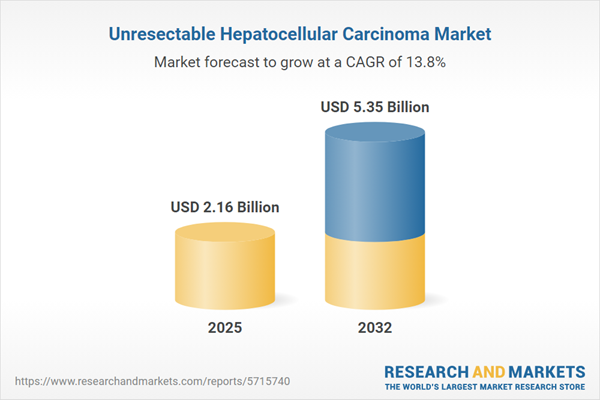Speak directly to the analyst to clarify any post sales queries you may have.
The unresectable hepatocellular carcinoma market confronts continuous change driven by emerging therapies, evolving regulatory frameworks, and new payer demands. Senior decision-makers benefit from timely insights that clarify the landscape and support strategic resource allocation in this dynamic oncology field.
Market Snapshot: Unresectable Hepatocellular Carcinoma Market Overview
The unresectable hepatocellular carcinoma (uHCC) market is projected to grow from USD 1.90 billion in 2024 to USD 2.16 billion in 2025 at a CAGR of 13.81 percent, reaching USD 5.35 billion by 2032. Growth reflects the increasing adoption of immunotherapies, the introduction of more diverse targeted treatments, and the implementation of newer reimbursement models. Competitive forces are prompting organizations to alter investment strategies and modernize market access plans, while more rigorous payer requirements reshape how companies approach commercial potential. Life sciences organizations are adjusting with proactive, results-oriented tactics in tumor management, balancing emerging clinical approaches alongside evolving business objectives in the uHCC marketplace.
Scope & Segmentation: Strategic Insights for Leadership
This report delivers a robust analytical structure for senior executives, detailing the most relevant segmentation drivers that shape resource allocation and enduring market performance within the uHCC sector:
- Therapy Types: Combination therapies, locoregional procedures, systemic treatments, and supportive care options contribute to customizable patient management pathways and specialized commercial opportunities.
- Mechanisms of Action: Immune checkpoint inhibitors (including CTLA-4, PD-1, PD-L1), kinase inhibitors, and mTOR inhibitors guide strategic research decisions and shape technology uptake throughout the drug development pipeline.
- Line of Therapy: Approaches for first-line, second-line, and third-line therapy directly influence portfolio strategies and enable organizations to adapt as clinical standards and protocols evolve.
- Formulations: Injectable and oral forms impact patient adherence, supply chain scalability, and integration flexibility within varying healthcare system contexts.
- Distribution Channels: Hospital, retail, and online channels establish access strategies, supporting stable and continuous product supply to diverse markets.
- End User Settings: Home care, outpatient clinics, and specialized hospitals respond to shifting care delivery models and address changing operational needs.
- Geographical Coverage: Includes in-depth analysis of the Americas, Europe, Middle East and Africa, and Asia-Pacific. Regional granularity highlights trends such as evolving epidemiology and reimbursement shifts, with particular focus on rapid developments in China, India, and Japan.
- Key Innovators Profiled: Leading companies such as F. Hoffmann-La Roche Ltd, Genentech, Eisai, Bayer, Merck, Bristol-Myers Squibb, Exelixis, and Eli Lilly demonstrate wide-ranging research expertise and established commercial operations across the uHCC market landscape.
Key Takeaways for Senior Decision-Makers
- Molecular and immunotherapy advances foster new cross-industry collaborations and promote distinctive methods of patient care, strengthening competitive positioning in the uHCC sector.
- Rapid regulatory and policy changes necessitate coordinated, cross-functional responses to accelerate time-to-market and ensure effective launch preparation in oncology portfolios.
- Expanding distribution models that incorporate digital and physical networks help organizations reduce supply chain risks and maintain dependable market presence across regions.
- Region-specific approaches, especially in Asia-Pacific, are vital for navigating differences in healthcare infrastructure and reimbursement environments and unlocking full market potential.
- Adoption of health technology solutions and data-driven market segmentation enhances stakeholder engagement and allows for more precise allocation of resources in complex care settings.
- Strategic relationships, including co-development and licensing, enable broader portfolio offerings and help maintain adaptability as sector priorities shift.
Tariff Impact: Navigating Policy Shifts for Supply Continuity
Recent changes to U.S. tariffs on imported pharmaceuticals impose increased cost challenges for market participants. To sustain resilience, organizations must reevaluate procurement and production strategies, diversify supplier bases, and reinforce risk management. These actions protect ongoing drug development and preserve patient access as global distribution networks adapt to new policy conditions.
Methodology & Data Sources
The findings combine structured interviews with oncologists, industry executives, and scientific authorities with systematic literature analysis and regulatory documentation reviews. All conclusions are supported by advanced quantitative models to provide reliability and business relevance for senior leadership.
Why This Report Matters for Oncology Market Stakeholders
- Delivers an evidence-based framework for investment decisions and sharper commercialization strategies in the unresectable hepatocellular carcinoma market.
- Improves risk assessment through detailed segment insights aligned with evolving industry dynamics and business goals.
- Equips decision-makers to respond effectively to policy changes and capitalize on emerging opportunities as the competitive environment develops.
Conclusion
Ongoing adaptability, informed strategies, and operational focus enable organizations to capture value and remain competitive in the constantly changing unresectable hepatocellular carcinoma market landscape.
Additional Product Information:
- Purchase of this report includes 1 year online access with quarterly updates.
- This report can be updated on request. Please contact our Customer Experience team using the Ask a Question widget on our website.
Table of Contents
3. Executive Summary
4. Market Overview
7. Cumulative Impact of Artificial Intelligence 2025
Companies Mentioned
The companies profiled in this Unresectable Hepatocellular Carcinoma market report include:- F. Hoffmann-La Roche Ltd
- Genentech, Inc.
- Eisai Co., Ltd.
- Bayer AG
- Merck & Co., Inc.
- Bristol-Myers Squibb Company
- Exelixis, Inc.
- Eli Lilly and Company
Table Information
| Report Attribute | Details |
|---|---|
| No. of Pages | 192 |
| Published | November 2025 |
| Forecast Period | 2025 - 2032 |
| Estimated Market Value ( USD | $ 2.16 Billion |
| Forecasted Market Value ( USD | $ 5.35 Billion |
| Compound Annual Growth Rate | 13.8% |
| Regions Covered | Global |
| No. of Companies Mentioned | 9 |









